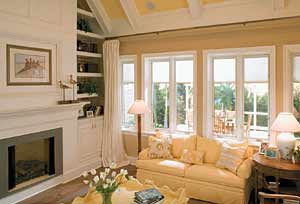Full Circle: Fenestration for the Complete Building Envelope
Enter the Next Generation
�This is a �next generation� standard, completely revised and updated,� said Joe Hayden, Senior Certification Engineer, Pella Corporation, Pella, Iowa. �It now includes all types of hinged doors, formerly known as patio and terrace doors and encompasses entry doors as well. In addition, this is an international standard, with the new version adopted by the Canadian Standards Association. It�s a single-source specification for windows, doors, and unit skylights for both the U.S. and Canada,� he said. Hayden chairs WDMA�s Exterior Fenestration Standards Committee.
Addressing Doors in the Real World
Overall, AAMA/WDMA/CSA 101/I.S.2/A440-05 contains provisions for side-hinged exterior doors that are more appropriate for their typical design and intended use. However, hinged doors, whether used as a required exit, as is the case with most entry doors, or as part of non-required exit systems as is often the case with �patio doors� or French doors (and other similar terms), do not typically include track systems that would permit the same level of water penetration resistance as sliding glass doors. In fact, entry doors used as required exits also have threshold limitations imposed to allow for ease of access and emergency escape and rescue. AAMA and WDMA memberships did not intend and do not expect hinged doors to meet the same level of water penetration as sliding glass doors. For this reason, and because a side-hinged exterior door can be expected to operate a significantly greater number of times, the introduction of a Cycling Performance category and a �Limited Water� (LW) rating was developed.
|
Limited Water Penetration Resistance Testing and Performance
The �Limited Water� (LW) rating for exterior side-hinged doors is an important part of the document, again, focusing on real-world applications. The LW product type designation concludes that the water penetration resistance performance is achieved by testing at a pressure less than the minimum test pressure required for the indicated performance class and performance grade (design pressure). LW ratings are only permitted for side-hinged door systems and are not allowed for any other product type.
Performance Classes and Levels
Five performance classes of windows, doors, and unit skylights are included in the Standard/Specification. The performance classes are designated R, LC, C, HC, and AW. This classification system provides for several levels of performance. Flexibility in the standard and determining applicability, depending on the environment, is critical to the proper implementation of the standard. For example, the performance class rating should be regarded as an indication of the level of performance, with the least stringent requirements established for the R performance class and the most stringent for the AW performance class.
The following descriptions can be used as a general guide in helping to determine which class is likely suited for a particular application:
R: commonly used in one- and two-family dwellings.
LC: commonly used in low-rise multi-family dwellings, low-rise professional offices (doctor, dentist, law), libraries, and low-rise motels.
C: commonly used in lighter-use industrial buildings and factories, hotels, and retail sales buildings.
HC: commonly used in hospitals, schools, institutions, dormitories, government or public buildings, and other facilities where heavy use of the fenestration products is expected. Also, commonly used on mid-rise buildings with increased loading requirements.
AW: commonly used in hospitals, schools, institutions, and public buildings, or on high-rise, and mid-rise buildings to meet increased loading requirements; also used in buildings where possible misuse of the fenestration products is expected.
Other design criteria include minimum design pressures, uniform load structural test pressures, and water penetration resistance test pressures for the fire performance classes. (Table 1)
The architect and specifier can select the appropriate level of performance depending on map wind speed, climate conditions, height of installation, type of building, type of window, door or unit skylight, durability, and other factors. In many cases, the appropriate level of performance classification will not correspond with the general use of the building or the use group occupancy assigned to the building in accordance with the local building code. For example, many residential buildings are constructed in locations subject to severe weather that require high-performance fenestration products rather than those that meet only the R requirements. On the other hand, many hospitals, schools, and institutions may successfully use products meeting R, LC, and C requirements. In other words, it�s up to the architect and specifier to fine-tune their selection for the application, and this standard/specification will help them do just that.










